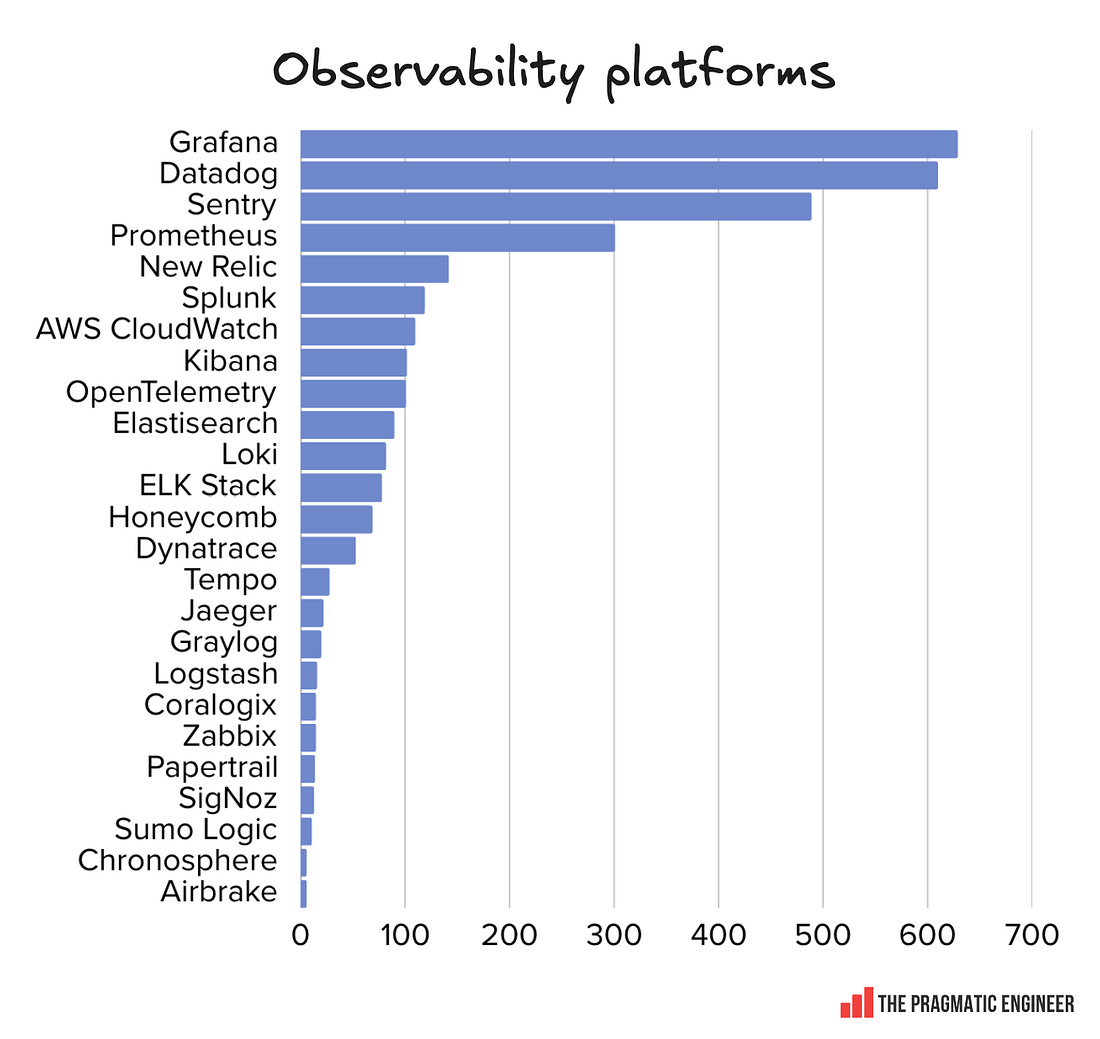|
 |
The Pragmatic Engineer 2025 Survey: What’s in your tech stack? Part 3
Which tools do software engineers use for observability, oncall tooling, feature flags, frontend & mobile work, and for developer tooling? Results from our survey, based on 3,000+ responses by readers
Hi – this is Gergely with the monthly, free issue of the Pragmatic Engineer Newsletter. In every issue, I cover challenges at Big Tech and startups through the lens of senior engineers and engineering leaders. If you’ve been forwarded this email, you can subscribe here.
Many subscribers expense this newsletter to their learning and development budget. If you have such a budget, here’s an email you could send to your manager.
During April and May, we asked readers which tools you use in your stack, and your opinions of them. Previous articles in this mini-series about the results of that survey have focused on AI-related tools, IDEs, and CI/CD in Part 1, while Part 2 covered project management, collaboration tools, databases, and backend-related tools.
In the third and final part of this dive into the feedback, we cover:
Observability, monitoring, and logging. Grafana, Datadog, and Sentry all stand out, with a long list of open source tools and vendors offering observability platforms.
Oncall tooling and incident management. PagerDuty and OpsGenie remain the most-used solutions, but young startups like incident.io, Rootly, and FireHydrant are challenging them.
Feature flags, analytics, and experimentation. LaunchDarkly is the most-used solution, with a long tail of analytics, experimentation, and feature flag vendors.
Frontend and mobile tooling. React is the most popular frontend framework, and Next.js is the most popular “meta frontend framework”. React Native is the most-mentioned cross-platform mobile framework. In these categories, it’s not even a contest.
Developer tools. Postman is popular for API development, Sonar for static analysis, and Backstage for developer portals.
Custom-built tools. Feature flagging, A/B testing, and CI/CD systems are the most common reasons to build custom tools.
Niche tools readers love. Lesser mentioned tools that are highly rated by readers, like Tuple (remote pair programming), Tmux (terminal multiplexer), Ansible (infrastructure automation), and many others.
As mentioned, check out more on the latest survey results in other articles, including:
Demographics
AI tools
Most used, most-loved programming languages
Most hated (and loved) tools
IDEs and terminals
Version control and CI/CD
Cloud providers, IaaS, and PaaS
Most-mentioned tools
Project management
Communication and collaboration
Databases and data stores
Backend infrastructure
Load balancers
Forks of popular open-source projects
1. Observability, monitoring, and logging
The leading observability vendor in this space, Datadog, was founded in 2010 with a focus on server and infrastructure monitoring: collecting metrics from servers, cloud instances, and with AWS as a focal point. Since then, Datadog has continued adding new products, and now supports dozens of features from APM (Application Performance Monitoring – distributed tracing, service maps), through RUM (Real User Monitoring – frontend performance, user sessions), to CI/CD visibility (pipeline monitoring, test analytics), and dozens more products. Datadog lists more than 50 on its website, and most are integrated to work together.
Other platforms are similar: they started with a narrow focus, added more capabilities, and became the full-blown platforms of today. A good example is Sentry: it started in 2008 as an open source monitoring tool for the Django platform in Python, then got incorporated in 2015 as a company, and today has products for APM (Application Performance Monitoring), error monitoring, session replay, and more.
With the caveat that comparing vendors in this crowded space is no simple task, below are listed the most-mentioned observability platforms by 3,000 respondents. (Thanks again to everyone who filled in the survey!):
Open source tools: several of these tools are open source (meaning they have permissive licenses):
Grafana: an open source tool for displaying dashboards for observability. It’s often used with Prometheus, Elasticsearch, and other backend observability databases. Grafana Labs (creator of the project) offers a managed service and additional products like Loki and Tempo.
Prometheus: an open-source metrics monitoring system originally built at SoundCloud. It’s the de facto standard for Kubernetes monitoring, and often paired with Grafana for visualization.
OpenTelemetry: an open-source observability framework providing standardized APIs, SDKs, and tools for instrumenting applications to collect traces, metrics, and logs.
Elasticsearch is an open-source distributed search and analytics engine, designed for storing and querying large volumes of data in near-real time. Elasticsearch moved from being open source
